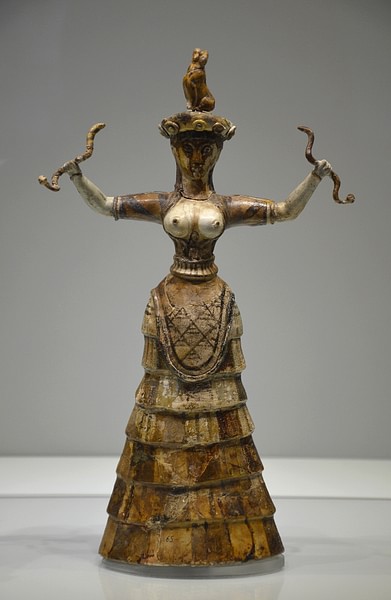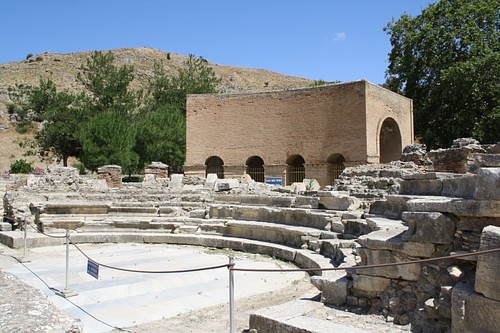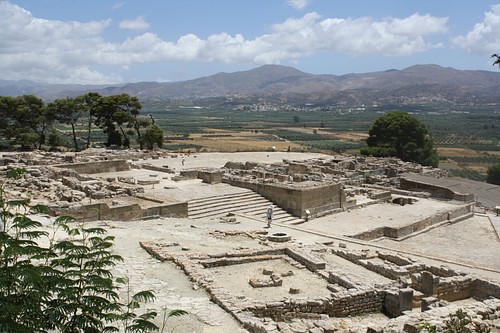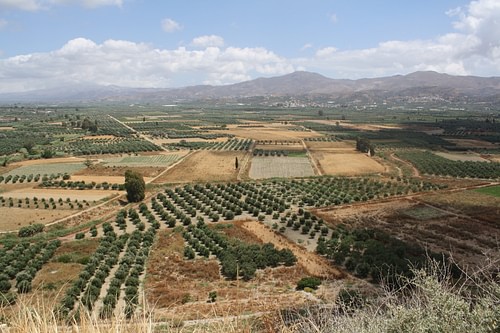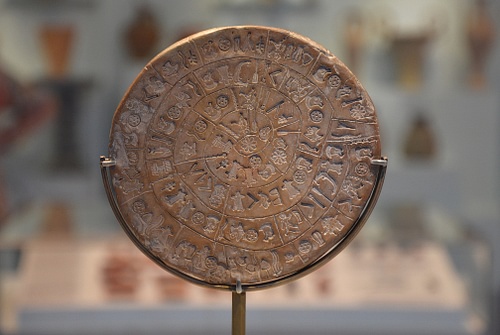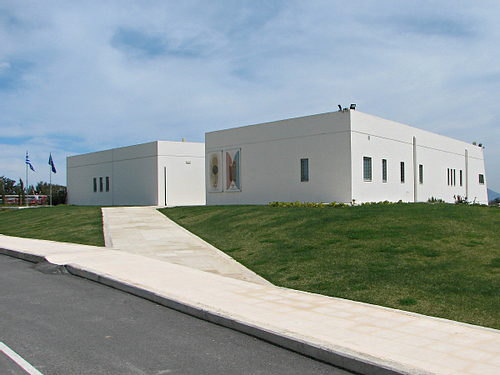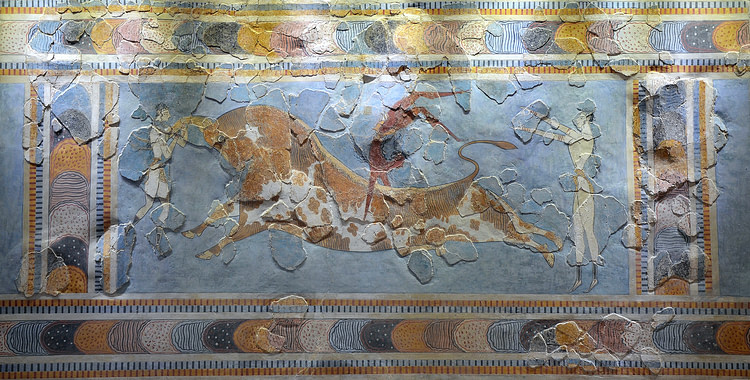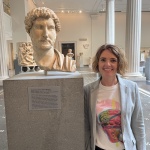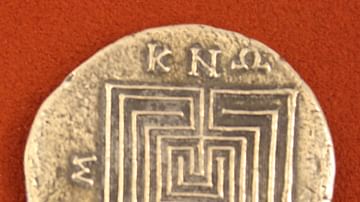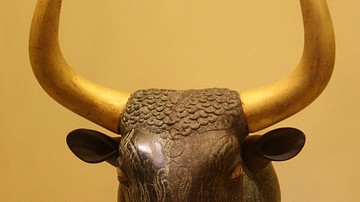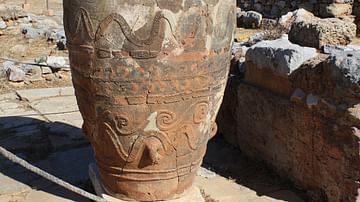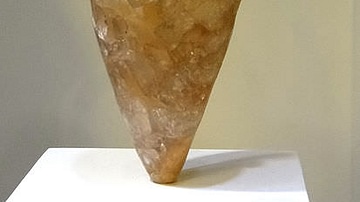As the cradle of European civilization and a meeting place of diverse cultures, Crete is a magical island that stands apart in the heart of the Mediterranean sea. Its prominent place in world history dates back to the mysterious and fascinating Bronze Age civilization of the Minoans, who were building lavish labyrinth-like palaces at a time when Athens was just a village. In the Odyssey, Homer describes Crete as a rich land, filled with countless people who speak several languages. The location of this mountainous island, at a crossroad of three continents, has been a natural outpost of consecutive invaders, including the Greeks, Romans, Venetians, and Ottomans, who have left their mark on Cretan culture.
Remainders of Crete's extraordinary past are scattered all over the island. Today, travellers come to explore and discover not only its five-millennium-old history but also its extraordinary natural beauty and diversity. As I journeyed through the Cretan landscape, I visited its most important ancient sites, including the famous Minoan palaces, but also veered off the beaten track to explore the lesser-known archaeological remains. In this tour of western Crete, I invite you to delve into the long and rich history of this fascinating island.
The Minoan civilization emerged on the island of Crete in the Early Bronze Age at the end of the third and beginning of the second millennium BCE. It flourished from c. 2000 BCE until c. 1500 BCE with the establishment of centres, called "palaces" by modern archaeologists, that concentrated political and economic powers, as well as artistic activities. Of particular significance was the religious role played by the palaces in the cult of the Mother Goddess. These impressive edifices were built at Knossos and Malia in the northern part of the island, at Phaistos in the south, and Zakros in the east, all sites with a rich agricultural hinterland and direct access to the most important sea routes of the time.
The British archaeologist Sir Arthur Evans discovered the first of these palaces in Knossos in 1900 CE and named the people who built them after the legendary King Minos. It was King Monos who, according to tradition, ordered the construction of a labyrinth in Knossos to hold the Minotaur, the mythical half-man, half-bull creature. The Minoan culture spread throughout the entire eastern Mediterranean world and its stunning art and architecture deeply influenced the Mycenaean Civilization (1600-1100 BCE) that would succeed it. After the downfall of the Mycenaeans, Crete was ruled by various ancient Greek city-states until the Romans conquered the island in 69 BCE and made Gortyn their capital.
Under Roman rule, Crete re-emerged as a major cultural centre and became the joint province of Crete and Cyrenaica and a centre of early Christianity. When the Roman Empire split into two, Crete was made part of the Eastern Empire. It continued to prosper during the Byzantine era until it faced repeated Arab raids and, ultimately, full conquest in the 820s CE.
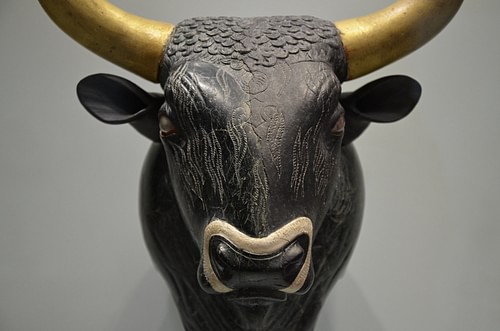
Today the central and western parts of the island are blessed with archaeological treasures which include the famous sites of Knossos, Phaistos and Gortyn but also Aptera, Phalasarna and Eleutherna, all with significant architectural remains as compelling evidence of Crete's long and varied history.
Knossos
The archaeological site of Knossos is located just 5 kilometres (3 mi) south of Heraklion and is Crete's most famous historical attraction. The rather extensive early 20th-century restorations carried out by Evans bring to life the palace's most significant parts and enable the visitor to appreciate the sophisticated architecture of this extensive and many-storied building complex. Legend has it that Knossos was the residence of the mythical ruler of Crete, King Minos. The Greeks called the palace of Minos 'Labyrinth' and described it as an enormous building with countless rooms and corridors. The first palace at Knossos was founded c. 1900 BCE on the ruins of a much older settlement but was destroyed by an earthquake around 1700 BCE. It was rebuilt on a grander scale on the same site and flourished in the Neopalatial period (1750-1430 BCE).

The palace consisted of wings arranged around a central paved courtyard. The two-storey West Wing housed the storerooms, the sanctuaries, the Throne Room and, on the upper floors, the banquet halls. The East Wing contained the private apartments, the workshops and a shrine. Public and private buildings were decorated with frescoes of exquisite artistry and craftsmanship. The remains we see today are mostly those of the second palace, rebuilt after the destruction of 1700 BCE and occupied, with increasing Mycenaean influence, through to 1450 BCE.
The tour of the palace starts from the West Court which is thought to have been a marketplace or the site of public gatherings. From here, a walk along the Corridor of the Procession leads to the partially restored South Propylaea, decorated with copies of parts of the Procession Fresco depicting four male figures (gift bearers) wearing the characteristic Minoan dress.

A great staircase then leads to the upper floor of the West Wing, which Evans named Piano Nobile after the architectural term of the Italian Renaissance palazzi. From the upper floor, visitors can look down on the complex of the West Magazines where about 400 giant pithoi (clay jars) that once held oil and wine were stored.

Just below the Piano Nobile lies the Central Court of the Palace. Situated in the centre of the complex, this large open area would have been ideal for religious celebrations and even for bull games. Some of the most important parts of the palace faced directly onto the court. On its west side was the Throne Room with its alabaster throne (considered the oldest in Europe), benches on each side and porphyrite basin. The walls are beautifully decorated with frescoes of griffins, mythical beasts regarded as sacred by the Minoans. The Throne Room was a chamber built for sacred ceremonials and was part of a larger complex that also included an anteroom and an inner chamber.

To the right of the Throne Room is a three-sectioned room that Evans called the Tripartite Shrine. It was the main sanctuary in Knossos where the famous Snake Goddess statue was found.
Crossing the central court takes the visitor to the East Wing which accommodated the royal quarters. The highlight of this wing is the Grand Staircase and the rooms below it. The Grand Staircase was the largest staircase in the palace and has been described as one of the masterpieces of Minoan architecture. The two lower levels are original while the two upper have been restored.
Down below lies the restored complex of megara that has been identified as the Royal Apartments of the palace. The first of these apartments is the largely restored Queen's Megaron which was adorned with frescoes that today are preserved as copies in their original position. The most striking is the fresco of the Dolphins which decorated the upper part of the north wall. The small adjacent chamber was the queen's bathroom with, beside it, the queen's toilet room.

Adjoining the Queen's Megaron is the King's Megaron, or Hall of the Double Axes as it was named from the presence of this sacred symbol on the wall. The Hall of the Double Axes was a double chamber with inner and outer space.
Walking towards the north section of the palace, visitors pass the workshop area where the excavators found a number of very large storage jars and the House of the Chancel Screen that belongs to the New Palace Period (1700 - 1450 BCE). The north section is dominated on its west side by the North Propylon with a copy of the Charging Bull relief fresco and the Pillar Hall, a large hall with a series of columns and pillars. Nearby lies the completely restored North Lustral Basin.

The last section of the palace is the so-called Theatre. It is a wide paved area extending on many levels and having two wings with low steps enclosing a paved level. It is estimated that the tiers could have held 500 standing spectators who came to watch acrobatic and dance performances.

The city of Knossos spread out around the palace, over a wide area of some 750,000 m², with particularly important monuments and buildings, roads, cemeteries, workshops, quarries and sacred spaces. Located northeast of the Great Palace is the Royal Villa which was built on the east slope of the hill of Knossos. It consists of a ground floor and two other floors, which survive in relatively good condition.
Gortyn
The archaeological site of Gortyn (or Gortyna), the largest in Crete and one of the most fascinating, lies 45 kilometres (28 miles) south of Knossos in the middle of the Mesara plain. The ancient city was an important settlement throughout antiquity and became the capital of the Roman Province Creta et Cyrenaica in the late 1st century BCE. According to tradition, it is where Zeus, in the guise of a bull, brought the princess Europa from her home in Phoenicia. Homer mentions Gortyn in the Iliad as “having walls” and in the Odyssey as the place where Menelaus and his fleet of ships, returning home from the Trojan War, were blown off course to the Cretan coastline. Nowadays, Gortyn is particularly well known for its Law Code, the longest extant ancient Greek stone inscription in Greece.
The ruins of Gortyn are spread out over a two-kilometre-long square area, making this archaeological site one of the biggest in the whole of Greece. Sadly, most of the buildings are not easily explored and have been fenced off. The only structure fully accessible is the Odeon with the Law Code of Gortyn.
The archaeological site is divided into three parts: the Acropolis, the area north of the road where the most important buildings are located, and the fenced area south of the road. Most people only visit the north side past the ticket gate. However, several more important ancient structures are scattered south of the road, opposite the entrance, as well as towards the Acropolis.
The first significant monument visible on the north side is the Church of Saint Titus (Hagios Titos) built in the 6th century CE. Saint Titus (1st century CE) was the first Bishop of Crete who was appointed by the Apostle Paul and who undertook the task of disseminating the Christian religion throughout the island.
A few steps away is the Roman Odeum which was built in the 1st century BCE and was later restored under the emperor Trajan in around 100 CE. It was a roofed building used for musical and theatrical performances. Its cavea was supported by a vaulted arcade which sheltered the famous law code discovered in 1884 CE. The 600 lines written in a Dorian dialect and dating to the first half of the 5th century BCE is the earliest law code discovered from the world of the ancient Greeks. The inscription, inscribed in the boustrophedon system of writing (alternate lines in opposite directions), provides important information on the laws of Gortyn and specifically its civil law. The code deals with matters surrounding the family and inheritance laws, adoptions, divorces as well as with crimes against morals (rapes, adultery) and the rights of women and slaves.
The most distinctive monuments on the south side are the praetorium, the residence of the Roman governor of the province, the temple of Pythian Apollo which was the main sanctuary of pre-Roman Gortyn, the sanctuary of the Egyptian Gods dedicated to Isis, Serapis and Anubis. Other remains, although less visible, include a theatre, an amphitheatre, a stadium, a nymphaeum as well as baths.


It is possible to climb up to the hilltop Acropolis. Set against the hillside are the remains of a large theatre. Once at the top you will be rewarded by the magnificent view of the whole area and the archaeological site itself. The Acropolis has some remains of the Archaic Temple of Athena which was converted into a basilica in the 6th century CE.
The finds from Gortyn are on display in the Heraklion Archaeological Museum and the Sculpture Gallery at the site, the most impressive of which is a Roman statue group of Persephone-Isis and Pluto-Serapis with the three-headed dog Cerberus.
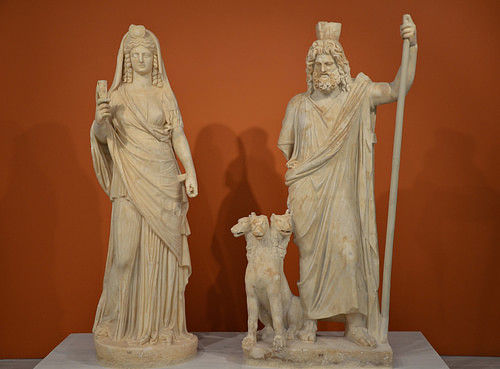
Phaistos
Phaistos, the second most important Minoan city after Knossos, is located 15 kilometres (9 miles) west of Gortyn. The site was inhabited from the Final Neolithic period (c. 3600-3000 BCE) until the foundation and development of the Minoan palaces. Like Knossos, the palace of Phaistos was laid out around a central peristyle court. It covered an area of approximately 8,000 square metres and extended over three stepped terraces. However, unlike Knossos, Phaistos has not been reconstructed, though the ruins are richly evocative.
The earliest palace at Phaistos was built at the beginning of the 2nd millennium BCE upon deposits dating from the Neolithic and Early Minoan periods (3000-2000 BCE). This early palace was destroyed and repaired on two occasions. After a third destruction about 1700 BCE, the ruins were razed to make way for the construction of the New Palace which was used until 1450 BCE. The ruins of the old and new palace are still preserved. They came to light during the excavations carried out by the Italian archaeologist F. Halbherr in the last two decades of the 19th century CE.
The palace of Phaistos, with its superb architectural composition, is considered to be a typical example of the Minoan palaces. As in Knossos, the nucleus of this large Minoan palace was the central peristyle court around which the rooms were arranged: the storerooms and shrines on the west side, the royal quarters on the north and the workshops on the east.
A visit to the palace begins at the upper level of the West Court which offers imposing views over the whole archaeological site. A stairway leads down to the Theatral Area where spectators would have watched some kind of performance or spectacle, and to circular structures (kouloures) that were used for the storage of grain.
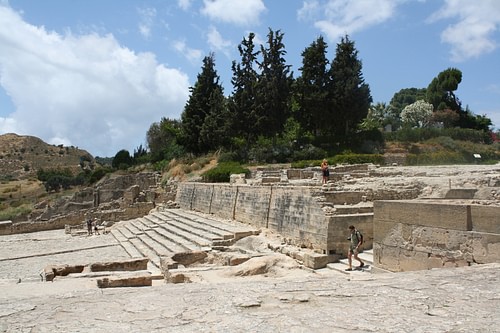
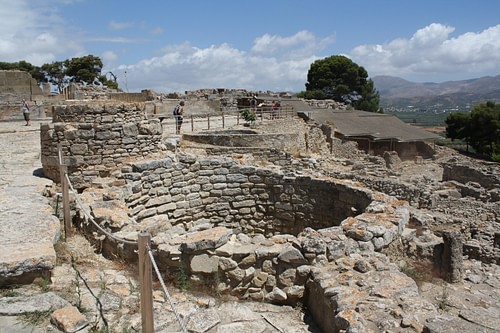
An impressive 15-metre-wide (49 ft) staircase gives access to the monumental West Propylaea which was the principal entrance to the New Palace. The Central Court preserves its original paving and leads to the royal apartments in the north part of the palace.
Phaistos continued to be inhabited in the Mycenaean (1600-1100 BCE) and Geometric periods (c. 11th -8th century BCE). In the Archaic period (7th century BCE) a temple, possibly dedicated to the goddess Rhea, was built on the remains from the Old Palace period, in the southern part of the palace. The Hellenistic city was extremely prosperous and houses dating from this period are to be seen in the west court (upper terrace) of the palace. Phaistos' independence was finally lost when it was conquered in c. 180 BCE by the neighbouring city of Gortyn.
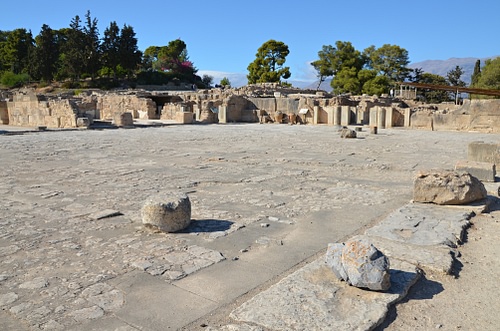
The majority of the findings from Phaistos are kept in the Archaeological Museum of Iraklion. The most important finding is the famous "Disc of Phaistos", a clay disk, dated to between 1950 BCE and 1400 BCE and impressed with a unique sophisticated hieroglyphic script.
Hagia Triada
A couple of kilometres to the west of Phaistos are the ruins of the small Minoan settlement of Hagia Triada. This enchanting site encompasses the vestiges of a royal villa and a Minoan town built on the northern slope of a range of hills overlooking the western end of the Mesara Plain.
The villa was built at the end of the Middle Minoan period in c. 1600 BCE and destroyed by fire around 1450 BCE. It had an unusual L shape consisting of a series of buildings on two sides of a courtyard, rather than the four sides of a conventional Minoan palace. However, the finds at the villa as well as its architecture suggest that it performed similar functions to the palaces. The villa contained rooms decorated with frescoes and equipped with wall panels made of alabaster, storage rooms, shrines, workshops, staircases, porticoes, paved courtyards etc.
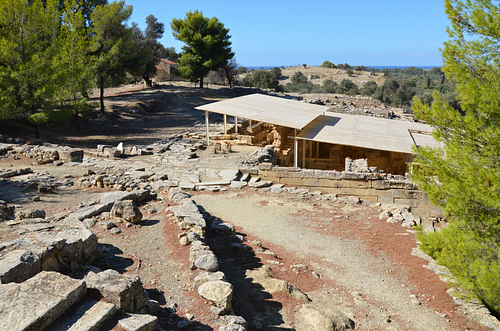
After its destruction in 1450 BCE, the villa was deserted until the arrival of the Mycenaeans when new buildings were erected over its ruins. An imposing megaron of the Mycenaean type was built in the Postpalatial period (1400-1100 BCE).
A ramp running along the northern side of the villa leads to the Minoan town with common residential buildings. Of special interest is a marketplace belonging to the Mycenaean era with eight spacious rooms, probably shops, arranged behind a portico.
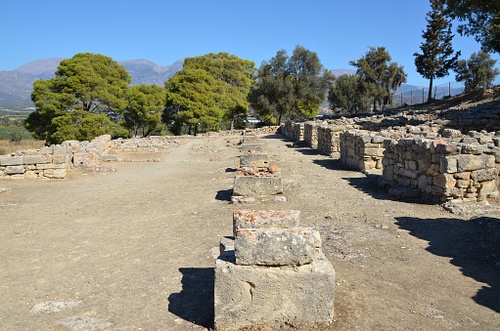
To the north-east of the town beyond the fence and closed to the visitors is a necropolis with two tholos tombs. The famous Hagia Triada sarcophagus decorated with funeral scenes was unearthed here.
Lying in the courtyard of the Minoan villa is a Byzantine single-aisled church dedicated to Saint George Galatas. The church is decorated with beautiful frescoes.
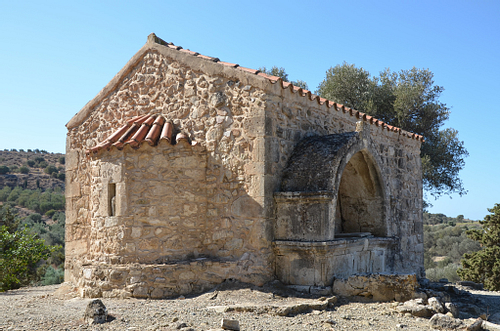
Eleutherna
The spectacularly sited archaeological site of Eleutherna is located 25 kilometres (15 mi) south-west of Rethymno near Mount Ida, the highest mountain in Crete on which lies, according to legend, the cave in which Zeus was born. Although Eleutherna has yielded Minoan artefacts dating back at least 4,000 years, it was during the Dark Ages of Greece's early history that the city flourished (800–450 BCE). Numerous significant artefacts from the 8th, 7th and early 6th centuries BCE have been found throughout nearly all of the city. Eleutherna also experienced economic and cultural heydays in the Hellenistic, Roman and Byzantine times. Its surrounding landscapes, rich in olive trees, stone, honey and other plant resources, contributed to the city's economic success.

The site of Eleutherna includes an acropolis, a polis (city), and a necropolis, spreading over an elongated ridge in the olive-tree-dotted foothills of sacred Mount Ida. Unfortunately, most of the site is currently fenced off as it is being excavated. The accessible remains include the ruins on the Acropolis with a Hellenistic tower at its entrance, two rock-cut Roman cisterns as well as of the remarkable stone-built Hellenistic bridge which has survived and is still in a good state of preservation in the valley.
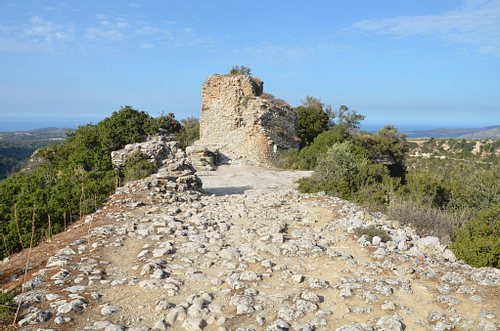
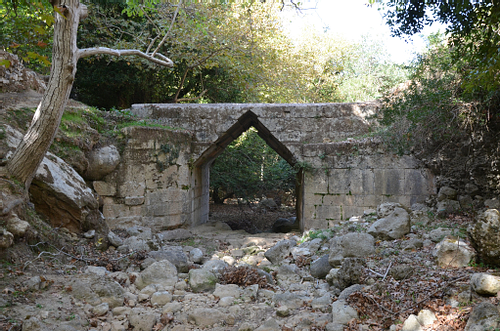
A team of archaeologists from the University of Crete has been excavated the site since 1984, unearthing important archaeological remains, including a necropolis dating back to the period of the Homeric epics (9th - 7th century BCE), as well as Hellenistic and Roman buildings and streets which had been built on top of earlier constructions. The discovery of lavish female burials in the Orthi Petra necropolis of Eleutherna was declared one of Top 10 Discoveries of 2009.
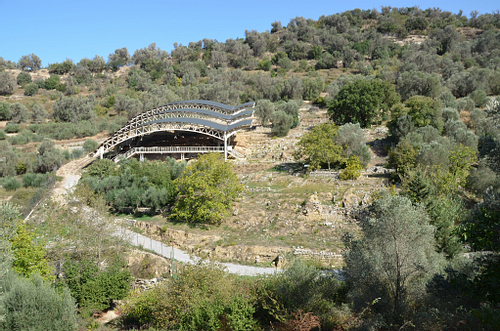
The necropolis has also yielded a number of high-quality grave goods from funeral pyres, cist tombs, and burials in pots from the 9th to the early 6th century BCE. The majority of the funerary practices at Orthi Petra were similar to Patroclus' cremation described by Homer in the Iliad.
The Museum of Ancient Eleutherna, directly linked to the archaeological site, was inaugurated in June 2016. This beautiful museum is a journey back to the dawn of Greek civilisation and Homer. Thousands of finds are showcased at the museum, shedding light on a long period of history spanning from 3000 BCE to the 14th century CE.
Aptera
The ancient town of Aptera lies on a low hill dominating the Souda Bay, about 13.5 kilometres (8 miles) east of Hania. Archaeological findings suggest that Aptera was founded in the Geometric period (8th century BCE) and reached its peak during the Hellenistic period (4th century BCE) as one of the most important and powerful city-states of ancient Crete. With its two ports, Aptera continued to be an important city during the Roman period and the early days of the Byzantine Empire before being destroyed by two earthquakes in the 4th and 7th centuries and then by the Saracens in 823 CE.
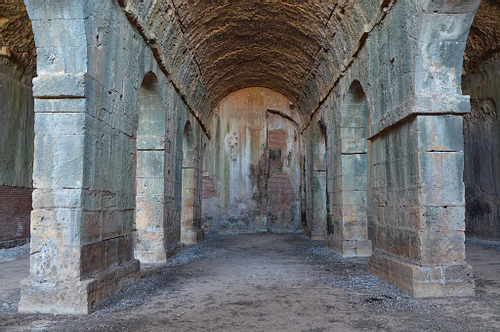
The French Archaeological School identified the ancient city in 1834 CE and conducted the first excavations in 1862 CE and 1864 CE. The most impressive of the preserved ancient buildings are the two Roman cisterns that served the needs of the city and supplied the facilities of the public and private baths. One can also see the remains of a small 5th-century BCE Doric temple dedicated to Artemis and her brother Apollo as well as the preserved ruins of a small theatre. The site is still being excavated. 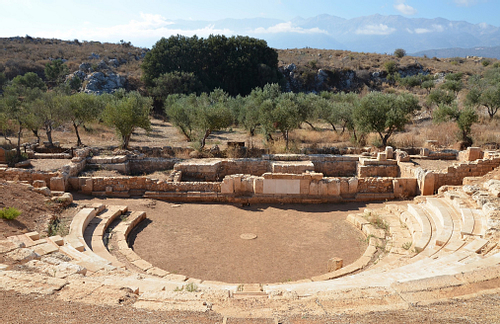
Phalasarna
Phalasarna's ruins are located in a gorgeous area on the west coast of Crete, some 16 kilometres (10 miles) west of Kissamos. Founded by Dorians Greeks around the 7th century BCE, the city was one of the most important ports of ancient Crete. From this spot, the Phalasarnians controlled the sea routes towards northern Africa and Italy. They traded with people all across the Mediterranean and had especially close relations with the Spartans and the Phoenicians. The city-state had laws, a complex system of social support, and minted its own silver and bronze coins. However, prosperity did not last long. A state of perpetual war with rival nearby cities-states, natural disasters and sea-level changes weakened and damaged the building and infrastructures of Phalasarna. The citizens turned to piracy and stirred the anger of Rome. The city's destruction probably came with the Romans in 67 BCE who aimed to eradicate piracy in the Mediterranean. In 365 CE, one of the greatest earthquakes in recorded history raised the land 6.5 m out of the sea and turned the harbour into dry land, buried under tons of landfill.
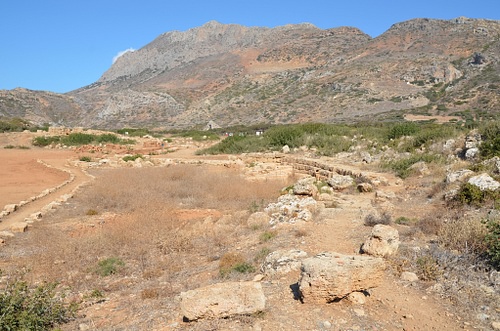
Rescue excavations first took place in 1966 and systematic archaeological research began in 1986 when the harbour was brought to light. The site is entered through a dirt track past olive groves and a large stone 'throne' which has been interpreted as a throne dedicated possibly to Poseidon, since Phalasarna was a maritime city
The scattered remnants include the city's inner harbour which was defended by part of the city wall linked by a number of towers, some of which are still standing. Excavations have also revealed blocks of built quay with bollard holes and mooring stones, workshops, five small terracotta baths and warehouses. More ruins can be seen ascending the Acropolis hill behind.
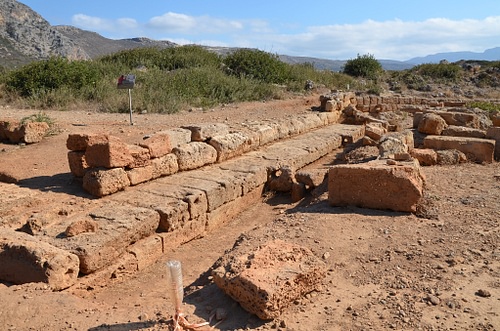
Heraklion Archaeological Museum
Heraklion's magnificent Archaeological Museum has reopened after a stunning seven-year makeover. It houses the finest and most important collection of Minoan art and artefacts anywhere in the world. A visit to Knossos and the other sites will be greatly enhanced if you have visited this museum first.
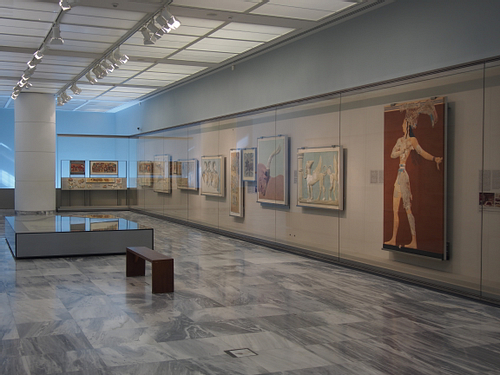
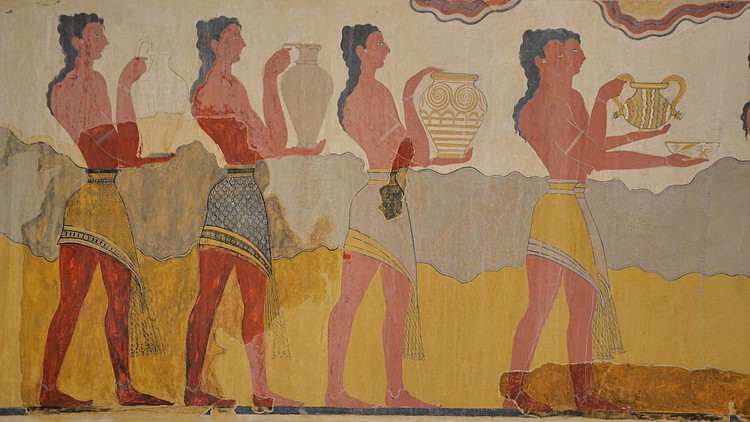
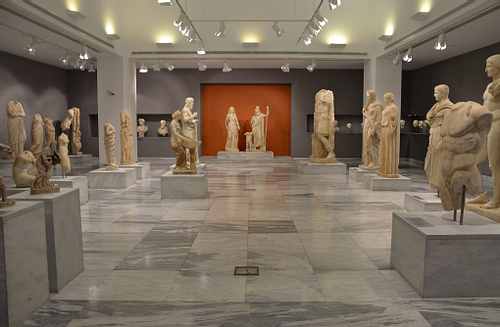
The permanent exhibition in the museum occupies a total of 27 rooms. Besides the Minoan collection, other periods of Cretan history are covered, from the Neolithic to the Greco-Roman period.
There are also archaeological museums in the five principal Cretan towns of Chania, Rethymno, Ierapetra, Kissamos and Sitia.


